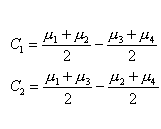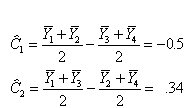7. Product and Process Comparisons
7.4. Comparisons based on data from more than two processes
7.4.7. How can we make multiple comparisons?
7.4.7.3. Bonferroni's method
|
|
Simple method
|
The Bonferroni method is a simple method that allows many comparison
statements to be made (or confidence intervals to be constructed)
while still assuring an overall confidence coefficient is
maintained.
|
|
Applies for a finite number of contrasts
|
This method applies to an ANOVA situation when the analyst has
picked out a particular set of pairwise comparisons or contrasts
or linear combinations in advance. This set is not infinite, as
in the Scheffé case, but may exceed the set of pairwise
comparisons specified in the Tukey procedure.
|
|
Valid for both equal and unequal sample sizes
|
The Bonferroni method is valid for equal and unequal sample sizes.
We restrict ourselves to only linear combinations or comparisons of
treatment level means (pairwise comparisons and contrasts are
special cases of linear combinations). We denote the number of
statements or comparisons in the finite set by g.
|
|
Bonferroni general inequality
|
Formally, the Bonferroni general inequality is presented by:
![P{PRODUCT[i=1 to g][A(i)]} >= SUM[i=1 to g][P[Abar(i)]]](eqns/bonfineq.gif)
where Ai and its complement
 are any events.
are any events.
|
|
Interpretation of Bonferroni inequality
|
In particular, if each Ai is the event that a
calculated confidence interval for a particular linear combination
of treatments includes the true value of that combination, then the
left-hand side of the inequality is the probability that all the
confidence intervals simultaneously cover their respective true
values. The right-hand side is one minus the sum of the
probabilities of each of the intervals missing their true values.
Therefore, if simultaneous multiple interval estimates are desired
with an overall confidence coefficient
1- ,
one can construct each interval with confidence coefficient
(1- ,
one can construct each interval with confidence coefficient
(1- /g),
and the Bonferroni inequality insures that the overall confidence
coefficient is at least
1- /g),
and the Bonferroni inequality insures that the overall confidence
coefficient is at least
1- . .
|
|
Formula for Bonferroni confidence interval
|
In summary, the Bonferroni method states that the confidence
coefficient is at least
1- that simultaneously all the following confidence limits for the
g linear combinations Ci are "correct"
(or capture their respective true values):
that simultaneously all the following confidence limits for the
g linear combinations Ci are "correct"
(or capture their respective true values):

where
![s(Chat(i)) = sigmahat(e)*SQRT{SUM[i=1 to r][c(i)**2/n(i)]}](eqns/bonf2.gif)
|
|
|
Example using Bonferroni method
|
|
Contrasts to estimate
|
We wish to estimate, as we did using
the Scheffe method, the following linear combinations
(contrasts):
 and construct 95 percent confidence intervals around the estimates.
and construct 95 percent confidence intervals around the estimates.
|
|
Compute the point estimates of the individual contrasts
|
The point estimates are:

|
|
Compute the point estimate and variance of C
|
As before, for both contrasts, we have
![SUM[i=1 to 4][c(i)**2/n(i)] = 4*(1/2)**2/5 = 0.2](eqns/scheffe8.gif) and
and
![s(Chat)**2 = sigmahat(e)**2*SUM[i=1 to 4][c(i)**2/4]
= 1.331*0.2 = 0.2661](eqns/cont3.gif)
where
 = 1.331 was computed in our
previous example. The
standard error is .5158 (the square root of .2661).
= 1.331 was computed in our
previous example. The
standard error is .5158 (the square root of .2661).
|
|
Compute the Bonferroni simultaneous confidence interval
|
For a 95 percent overall confidence coefficient using the Bonferroni
method, the t-value is t.05/(2*2);16 =
t.0125;16 = 2.473 (see the
t-distribution
critical value table in Chapter 1). Now we can calculate the
confidence intervals for the two contrasts. For C1
we have confidence limits -.5 ± 2.473 (.5158) and for
C2 we have confidence limits
.34 ± 2.473 (.5158).
Thus, the confidence intervals are:
-1.776  C1
C1
 0.776 0.776
-0.936  C2
C2
 1.616 1.616
|
|
Comparison to Scheffe interval
|
Notice that the Scheffé interval
for C1 is:
-2.108  C1
C1
 1.108 1.108
which is wider and therefore less attractive.
|
|
|
Comparison of Bonferroni Method with Scheffé
and Tukey Methods
|
|
|
|
|
No one comparison method is uniformly best - each has its uses
|
- If all pairwise comparisons are of interest, Tukey has the
edge. If only a subset of pairwise comparisons are required,
Bonferroni may sometimes be better.
- When the number of contrasts to be estimated is small,
(about as many as there are factors) Bonferroni is
better than Scheffé. Actually, unless the number of
desired contrasts is at least twice the number of factors,
Scheffé will always show wider confidence bands than
Bonferroni.
- Many computer packages include all three methods. So, study
the output and select the method with the smallest confidence
band.
- No single method of multiple comparisons is uniformly best
among all the methods.
|
|
|
|
![P{PRODUCT[i=1 to g][A(i)]} >= SUM[i=1 to g][P[Abar(i)]]](eqns/bonfineq.gif)
![]() are any events.
are any events.
 ,
one can construct each interval with confidence coefficient
(1-
,
one can construct each interval with confidence coefficient
(1- /g),
and the Bonferroni inequality insures that the overall confidence
coefficient is at least
1-
/g),
and the Bonferroni inequality insures that the overall confidence
coefficient is at least
1- .
.
 that simultaneously all the following confidence limits for the
g linear combinations Ci are "correct"
(or capture their respective true values):
that simultaneously all the following confidence limits for the
g linear combinations Ci are "correct"
(or capture their respective true values):

![s(Chat(i)) = sigmahat(e)*SQRT{SUM[i=1 to r][c(i)**2/n(i)]}](eqns/bonf2.gif)


![SUM[i=1 to 4][c(i)**2/n(i)] = 4*(1/2)**2/5 = 0.2](eqns/scheffe8.gif)
![s(Chat)**2 = sigmahat(e)**2*SUM[i=1 to 4][c(i)**2/4]
= 1.331*0.2 = 0.2661](eqns/cont3.gif)
 = 1.331 was computed in our
previous example. The
standard error is .5158 (the square root of .2661).
= 1.331 was computed in our
previous example. The
standard error is .5158 (the square root of .2661).
 C1
C1
 0.776
0.776
 C2
C2
 1.616
1.616
 C1
C1
 1.108
1.108

